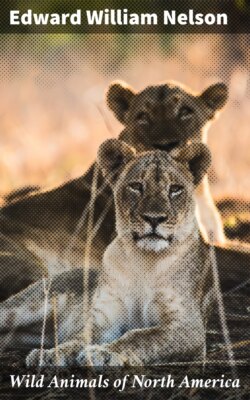Читать книгу Wild Animals of North America - Edward William Nelson - Страница 16
SAVING OUR WILD LIFE
ОглавлениеSeveral strong national organizations are doing great service in forwarding the conservation of wild life, as the National Geographic Society, the National Association of Audubon Societies, American Bison Society, Boone and Crockett Club, New York Zoölogical Society, American Game Protective and Propagation Association, Permanent Wild Life Protective Fund, and others. In addition, a large number of unofficial State organizations have been formed to assist in this work.
Through the authorization by Congress, the Federal Government is actively engaged in efforts for the protection and increase of our native birds and mammals. This work is done mainly through the Bureau of Biological Survey of the U. S. Department of Agriculture, which is in charge of the several Federal large-game preserves and nearly seventy bird reservations.
From a drawing by Charles R. Knight
A GROTESQUE CREATURE THAT ONCE LIVED IN THE UNITED STATES (UERTATHERIUM EOCENE, MIDDLE WYOMING)
It had six horns on the head and, in some species, two long canine teeth projecting downward from the upper jaw. The feet were somewhat like those of an elephant, but the skull and teeth resemble nothing on earth today.
On the large-game preserves are herds of buffalo, elk, deer, and antelope. The Yellowstone National Park, under the Department of the Interior, is one of the most wonderfully stocked game preserves in the world. In this beautiful tract of forest, lakes, rivers, and mountains live many moose, elk, deer, antelope, mountain sheep, black and grizzly bears, wolves, coyotes, mountain lions, and lynxes.
Practically all of the States have game and fish commissions in one form or another, with a warden service for the protection of game, and large numbers of State game preserves have been established. The increasing occupation of the country, the opening up of wild places, and the destruction of forests are rapidly restricting available haunts for game. This renders particularly opportune the present and increasing wide-spread interest in the welfare of the habitants of the wilderness.
The national forests offer an unrivaled opportunity for the protection and increase of game along broad and effective lines. At present the title to game mammals is vested in the States, among which great differences in protective laws and their administration in many cases jeopardize the future game supply.
If a coöperative working arrangement could be effected between the States and the Department of Agriculture, whereby the Department would have supervision and control over the game on the national forests, so far as concerns its protection and the designation of hunting areas, varying the quantity of game to be taken from definite areas in accordance with its abundance from season to season, while the States would control open seasons for shooting, the issuance of hunting licenses, and similar local matters, the future welfare of large game in the Western States would be assured.
From a drawing by Charles R. Knight
THE PRIMITIVE FOUR-TOED HORSE (EOHIPPUS, LOWER EOCENE, WYOMING)
The so-called four-toed horse, a little creature some 12 inches in height at the shoulder, having four well-defined hoofs on the front foot and three on the hind foot. The animal is not a true horse, but was undoubtedly an ancestor (more or less direct) of the modern form. It must have been a very speedy type, which contributed greatly to the preservation of the species in an age when (so far as we know) the carnivores were rather slow and clumsy.
Under such an arrangement the game supply would be handled on business principles. When game becomes scarce in any restricted area, hunting could be suspended until the supply becomes renewed, while increased hunting could be allowed in areas where there is sufficient game to warrant it. In brief, big game could be handled by the common-sense methods now used so effectively in the stock industry on the open range. At present the lack of a definite general policy to safeguard our game supply and the resulting danger to our splendid native animals are deplorably in evidence.
A TRUE HORSE WHICH WAS FOUND IN THE FOSSIL BEDS OF TEXAS: PLEISTOCENE
It is interesting to note that this country was possessed of several species of wild horses, but these died out long before the advent of the Indian on this continent. The present wild horses of our western plains are merely stragglers from the herds brought over by the Spaniards and other settlers. When Columbus discovered America there were no horses on the continent, though in North America horses and camels originated (see text, page 399).
From drawings by Charles R. Knight
THE FOREST HORSE OF NORTH AMERICA (HYPOHIPPOS MIOCENE)
This animal is supposed to have inhabited heavy undergrowth. It was somewhat off the true horse ancestry and had three rather stout toes on both the fore and hind feet.
Photograph by Gus A. Swanson
A MONTANA DOE AND FAWN
Observers of those times believed that at the beginning of the last century there were more deer and antelope in the United States than there were buffaloes. If that be true, they were probably more numerous than any domestic animal we have today.
Photograph by Gus A. Swanson
THE SPIRIT OF THE WILD
Timorous as a gazelle in the open, brave as a lion when forced to fight, with nerves as quick as lightning and sinews as hard as steel, these denizens of the deep wood match the wind for speed, are unsurpassed for endurance, and yield place to no other species in graceful beauty.
